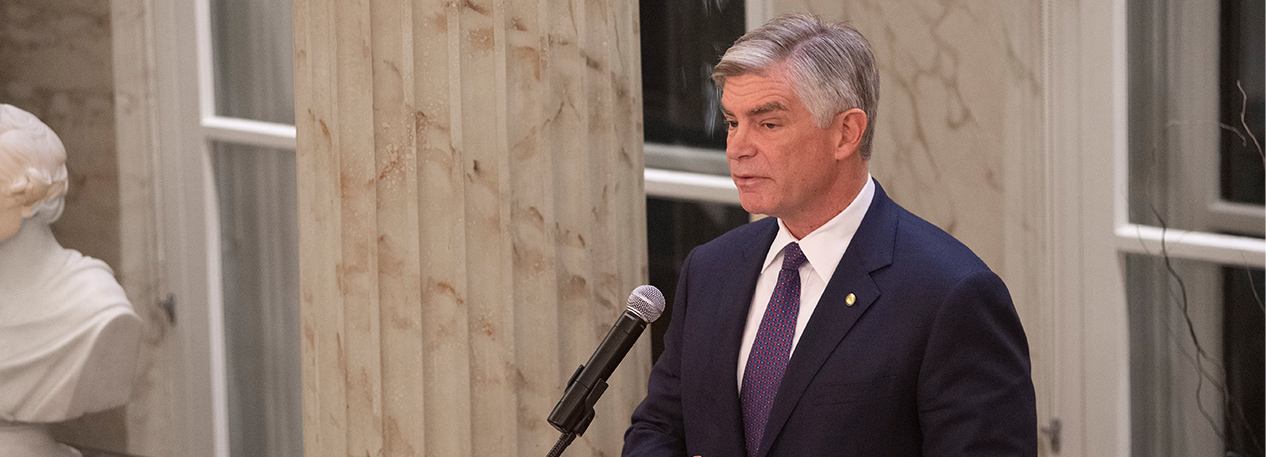Good afternoon. Thank you very much to Daniel for that introduction and a big thank you to everybody at both the Philadelphia and St. Louis Federal Reserve Banks who worked tirelessly to make this virtual event possible. We usually hold these biennial Reinventing Our Communities conferences in Philadelphia, though two years ago we met in Baltimore for the first time. Back then, we thought that was a big change! Little did we know …
Now, we may be meeting in a very different format this year, but I still have to begin by mentioning my usual Fed disclaimer: The views I express today are my own and do not necessarily reflect those of anyone else on the Federal Open Market Committee or in the Federal Reserve System.
The COVID-19 crisis has certainly changed America in the course of just a few months. Many of us have become expert “social distancers” and furious handwashers. Some of us have even become amateur barbers.
But in other important ways, this health crisis has not so much changed things as simply exposed, and in some cases accelerated, trends that were already present in our society.
The United States went into this crisis a troublingly unequal place, beset by serious inequities in income, wealth, and opportunity.
Perhaps most disturbing is that the multiyear economic expansion we experienced through much of the last decade did nothing to reduce American inequality. Indeed, last year, even as by many measures, the economy was in great shape, the Census Bureau calculated that income inequality in 2018 was the highest it had been in the 50 years it has measured it. The Gini coefficient — which measures the equality of income distribution — shows that incomes in the U.S. are far less equally distributed than in other industrialized countries like Germany and Japan.
Wealth inequality is even starker.
My colleagues at the St. Louis Fed calculated last year that, as of 2016, the top 10 percent of wealthiest American households owned 77 percent of the country’s total wealth. The bottom 50 percent owned only 1 percent. Fully 10 percent of American households had negative net worth, meaning their total household debt outstripped their assets.
Inequality and poverty touch all corners of America, from depopulating rural communities in the Great Plains, to postindustrial cities in the Northeast and Midwest, to neighborhoods in even some of our wealthiest cities like San Francisco and New York. But we can’t deny that certain communities have borne the brunt of these inequities more than others. It’s simply a fact that some of the underlying inequalities in our society deal with race. To cite just one example, as of 2016, the average family wealth of white families was nearly seven times greater than that of black families.
The health crisis has only heightened these inequities. For one, the coronavirus itself is affecting some communities more than others. In Philadelphia, more than half of those who have died from COVID-19 have been African American, despite African Americans making up only about 40 percent of the city’s population. This is a trend that has been observable nationwide.
And the economic costs of the health crisis have fallen on those least able to bear them as well.
Our researchers at the Philadelphia Fed have been studying closely which neighborhoods and households have been most affected by the economic shutdown. They’ve found that those most likely to be at risk of losing employment were already disproportionately low income.
In other words, both as a health and an economic crisis, COVID-19 has the cruel effect of hurting those who were already most vulnerable.
American inequality is a moral and ethical challenge to our country’s founding creed. But research shows it’s also a growing economic problem. The International Monetary Fund has found that when an additional 1 percent of income goes to the top 20 percent of income earners, GDP falls. But when the same gains are made by the bottom 20 percent, GDP rises.
That makes sense, of course: Those who earn less money are likely to spend it, whereas high earners save. That’s crucial because consumer spending accounts for about 70 percent of our country’s total GDP. Ensuring an equitable recovery from COVID-19 is critical in making sure the next expansion is not only fair but also strong and durable.
That’s why today’s discussion is so vitally important. Our role at the Fed is not to dictate fiscal policy but to use our academic and applied research, our outreach, and our convening powers to help policymakers all across the country better understand how to deal with these challenges.
Here at the Philadelphia Fed, we’ve launched the Economic Growth & Mobility Project, a multilevel effort to bring entrepreneurial solutions to achieve inclusive economic growth and create pathways out of poverty through the pillars of creating job opportunities, improving human capital, and addressing housing and infrastructure needs.
As this crisis continues, we must redouble our efforts to redress some of the great underlying challenges to our society. Thank you very much for being a part of this extremely important conversation.
- The views expressed here are the speaker’s own and do not necessarily reflect those of anyone else in the Federal Reserve System.

